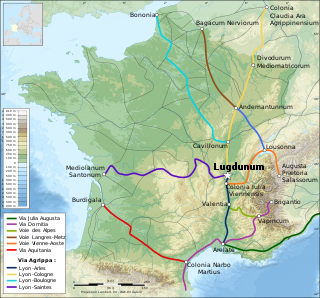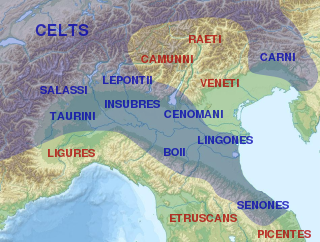During the 290s BC, Hellenistic civilization begins its emergence throughout the successor states of the former Argead Macedonian Empire of Alexander the Great, resulting in the diffusion of Greek culture throughout the Levant and advances in science, mathematics, philosophy, etc. Meanwhile, the Roman Republic is embroiled in war against the Samnites, the Mauryan Empire continues to thrive in Ancient India, and the Kingdom of Qin in Ancient China, the one which in the future will conquer its adversaries and unite China, begins to emerge as a significant power during the Warring States period.
Year 121 BC was a year of the pre-Julian Roman calendar. At the time it was known as the Year of the Consulship of Opimius and Allobrogicus and the Second Year of Yuanshou. The denomination 121 BC for this year has been used since the early medieval period, when the Anno Domini calendar era became the prevalent method in Europe for naming years.

Perseus was king of the ancient Greek kingdom of Macedon from 179 until 168 BC. He is widely regarded as the last king of Macedonia and the last ruler from the Antigonid Dynasty, as his defeat by Rome at the Battle of Pydna during the Third Macedonian War effectively ended Macedonia as an independent political entity.

Lucius Aemilius Paullus Macedonicus was a two-time consul of the Roman Republic and general, who conquered Macedon in the Third Macedonian War.

Gallia Aquitania, also known as Aquitaine or Aquitaine Gaul, was a province of the Roman Empire. It lies in present-day southwest France, where it gives its name to the modern region of Aquitaine. It was bordered by the provinces of Gallia Lugdunensis, Gallia Narbonensis, and Hispania Tarraconensis.

The Arverni were a Gallic people dwelling in the modern Auvergne region during the Iron Age and the Roman period. They were one of the most powerful tribes of ancient Gaul, contesting primacy over the region with the neighbouring Aedui.

Gallia Narbonensis was a Roman province located in what is now Occitania and Provence, in Southern France. It was also known as Provincia Nostra, because it was the first Roman province north of the Alps, and as Gallia Transalpina, distinguishing it from Cisalpine Gaul in Northern Italy. It became a Roman province in the late 2nd century BC. Gallia Narbonensis was bordered by the Pyrenees Mountains on the west, the Cévennes to the north, the Alps on the east, and the Gulf of Lion on the south; the province included the majority of the Rhone catchment. The western region of Gallia Narbonensis was known as Septimania. The province was a valuable part of the Roman Empire, owing to the Greek colony and later Roman Civitas of Massalia, its location between the Spanish provinces and Rome, and its financial output.

The Via Aquitania was a Roman road created in 118 BC in the Roman province of Gaul. It started at Narbonne, where it connected to the Via Domitia. It then went toward the Atlantic Ocean, via Toulouse and Bordeaux, covering approximately 400 kilometres (250 mi).

The Acta Triumphorum or Triumphalia, better known as the Fasti Triumphales, or Triumphal Fasti, is a calendar of Roman magistrates honoured with a celebratory procession known as a triumphus, or triumph, in recognition of an important military victory, from the earliest period down to 19 BC. Together with the related Fasti Capitolini and other, similar inscriptions found at Rome and elsewhere, they form part of a chronology referred to by various names, including the Fasti Annales or Historici, Fasti Consulares, or Consular Fasti, and frequently just the fasti.

Roman Gaul refers to Gaul under provincial rule in the Roman Empire from the 1st century BC to the 5th century AD.

Gnaeus Domitius Ahenobarbus was a Roman general and senator who served as consul in 122 BC. He led a campaign to conquer southern Gaul against the Allobroges together with his successor Quintus Fabius Maximus Allobrogicus. Domitius was active in the early development of southern Roman Gaul, establishing the first Roman colony at Colonia Narbon Martius, and sponsored projects such as the Via Domitia connecting Italy to Spain through southern Gaul. He was probably also the sponsor of the Altar of Domitius Ahenobarbus in the Temple of Neptune in Rome. Ahenobarbus was censor in 115 BC and became pontifex at an unknown date before dying c. 104 BC.
The Vocontii were a Gallic people dwelling on the western foothills of the Alps during the Iron Age and the Roman period.
Quintus Fabius Maximus was a general and politician of the late Roman Republic who became suffect consul in 45 BC.
Quintus Fabius Maximus Allobrogicus, was a Roman statesman and general who was elected consul in 121 BC. During his consulship he fought against the Arverni and the Allobroges whom he defeated in 120 BC. He was awarded a triumph and the agnomen Allobrogicus for his victory over the Gauls.

Alba-la-Romaine is a commune in the Ardèche department in the Auvergne-Rhône-Alpes region in Southern France.

The Ruteni were a Gallic tribe dwelling in the southern part of the Massif Central, around present-day Rodez, during the Iron Age and the Roman period.
The archaeological site of Alba-la-Romaine, corresponding to the Gallo-Roman city of Alba Augusta Helviorum or Alba Helviorum is located near the present town of Alba-la-Romaine. The site is in the French department of Ardèche, Rhône-Alpes. During the Roman Imperial era, Alba was the capital of the Celtic-speaking polity of Helvii, which had territory covering the area of lower Vivarais.

Over the course of nearly four centuries, the Roman Republic fought a series of wars against various Celtic tribes, whom they collectively described as Galli, or Gauls. Among the principal Gallic peoples described as antagonists by Greek and Roman writers were the Senones, Insubres, Boii, and Gaesatae.
The Battle of Vindalium took place near Vindalium, a Cavarian settlement probably corresponding to modern day Mourre-de-Sève in Sorgues, near the confluence of the Rhône and Durance rivers in Southern France. The battle opposed the Allobroges, a Gallic tribe dwelling further north between the Rhône and the Alps, to the Roman forces of proconsul Gnaeus Domitius Ahenobarbus.
The Battle of the Isère River took place near the modern day French town of Valence at the confluence of the Isère and Rhône rivers. A first confrontation had been won by Gnaeus Domitius Ahenobarbus at the Battle of Vindalium, further south in the Rhône Valley, before Ahenobarbus and Quintus Fabius Maximus Allobrogicus joined their forces, defeating a confederation of Allobroges, Arverni and some Salluvii warriors at the Isère River.












